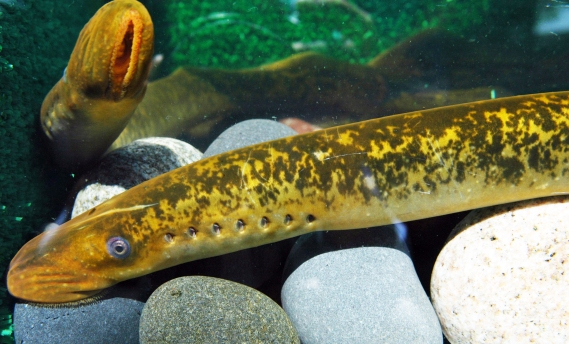
Researchers hope to rid the Upper Cheboygan River of sea lamprey by introducing sterile males. Photo: US Fish and Wildlife Service
By Howard Meyerson
Federal researchers working to control sea lampreys in the Cheboygan River Watershed are considering a chemical-free approach starting in 2017.
The four-year experiment would involve releasing sterile male lampreys in the Pigeon, Maple and Sturgeon Rivers.
All three are tributaries of the Cheboygan River, which has been found in recent years to have a landlocked lamprey population. Those lampreys, which don’t migrate out to Lake Huron to feed, emerge from river bottoms where they live as larvae, make their way downstream during their metamorphosis to a blood-sucking parasite, and feed on fish in Burt and Mullett lakes before returning upstream to spawn and die.
Two years of netting surveys found an annual total of 200 or fewer adult (spawning) lampreys in all three rivers combined, according to federal officials. A third year of data is being collected this summer.
The proposed experiment, to flood the system with 4,000 sterile males annually, would greatly reduce the odds of successful spawning by making it difficult for a normal female lamprey to find a normal male. Researchers say sterile males do not feed on fish. They would migrate upriver to spawn without success, lessening or eliminating the need to apply the lampricide TFM every four years, at a cost of $400,000. TFM targets and kills young lamprey larvae in stream bottoms. The sterile male release would target the adult spawners that survive the TFM treatment.
“These rivers have been producing larval lamprey for 50 years. They have been treated with lampricide every four years,” said Nick Johnson, research ecologist with the U.S. Geological Survey Great Lakes Science Center at Hammond Bay Biological Station. “We think it’s interesting that they still produce larval lamprey even with so few adults, so we want to focus on trying an alternative to control to delay chemical treatment. We haven’t got approval yet for the approach. But if it works as designed, they (the U.S. Fish and Wildlife Service) won’t need to apply lampricide in future years.”
Approval and funding for the four-year experiment, which is estimated to cost $100,000 each year, would come from the Great Lakes Fishery Commission. The request will be submitted if the results of this year’s netting survey is consistent with the prior two years. The sterile male approach is best used when only low numbers of adult lampreys are present.
“Chemicals are cost-effective for treating dense populations, but when we get down to the last few it isn’t very efficient,” says Mike Twohey, supervisor of the U.S. FWS adult lamprey unit at the agency’s Marquette Biological Station. “With sterile males, it’s just the opposite. When the population is small it is easy to overwhelm it with sterile males. We should see great success up there.”
GLFC spokesman, Marc Gayden, said the experiment will show whether it is a viable approach that could be used in other locations and could save money in the long run if TFM is not required.
“This would be proof of concept,” Gayden said. “If we can find alternatives that work and prove less expensive, we would diversify our approach to lamprey control and get more for less money.”
The sterile male approach was attempted on the St. Marys River in conjunction with adult lamprey trapping and TFM treatments, according to Twohey. The St Marys is a larger system and the sterile male component was discontinued in 2012 because the results from it proved inconclusive.
“We have an opportunity to learn and use it as a demonstration project,” Twohey said. “If we are successful we can use it in other river systems.”
Dave Borgeson, fisheries supervisor for the Michigan DNR’s Northern Lake Huron Management Unit said his agency supports trying the experiment.
“We would love to see it used where it can be effective,” Borgeson notes. “I know they tried it in a bigger river system, but I am excited to see if they can do it here and how it will work.”
_________________________
© 2015 Howard Meyerson
Appears in Michigan Outdoor News


Sterile males! Why didn’t I think of that?
LikeLiked by 1 person
Finally I see a real promising strategy with a army of sterile males, one or two mop up treatments, and fatal knockout with sterile males. This would be a nice retirement achievement for Mike Twohey. This is a great strategy compliment for the local watersheds with their trout habitat restoration projects. The future is looking good.
LikeLiked by 1 person
Tom. Thanks for your comment. I agree. This could be a really interesting chapter.
LikeLike